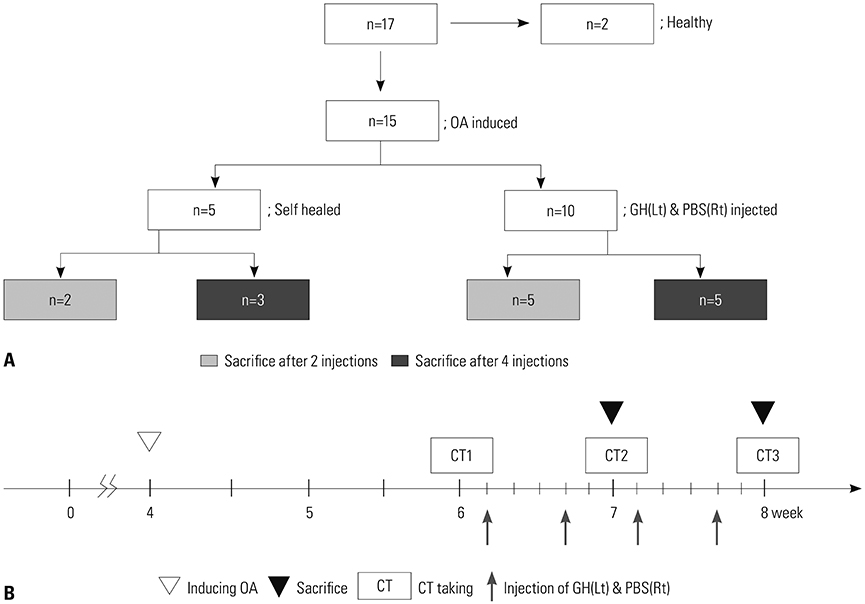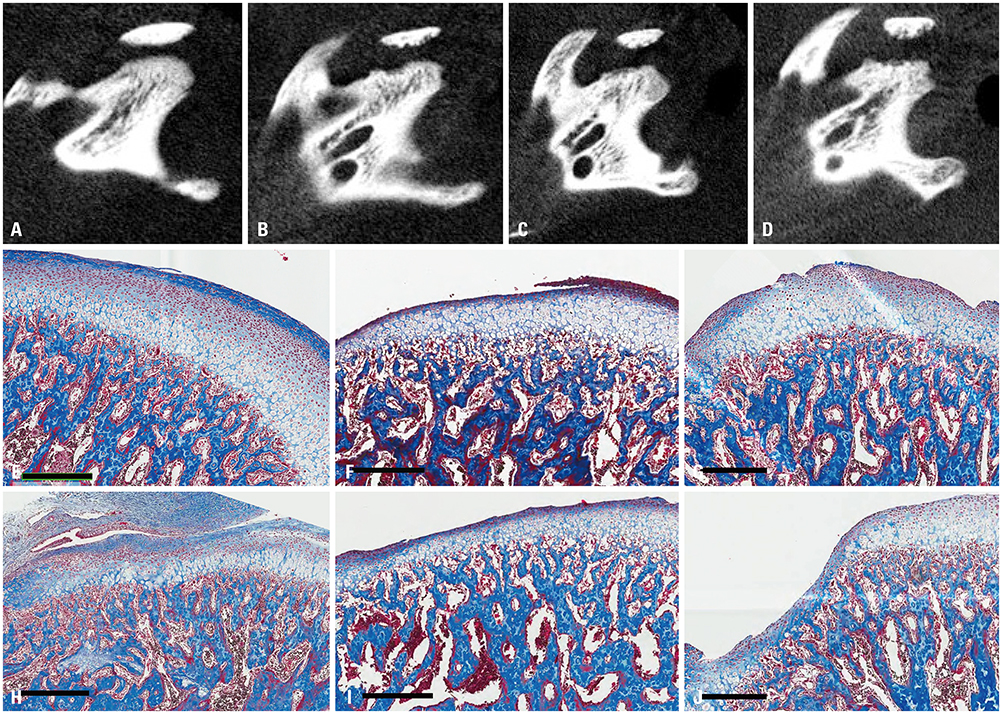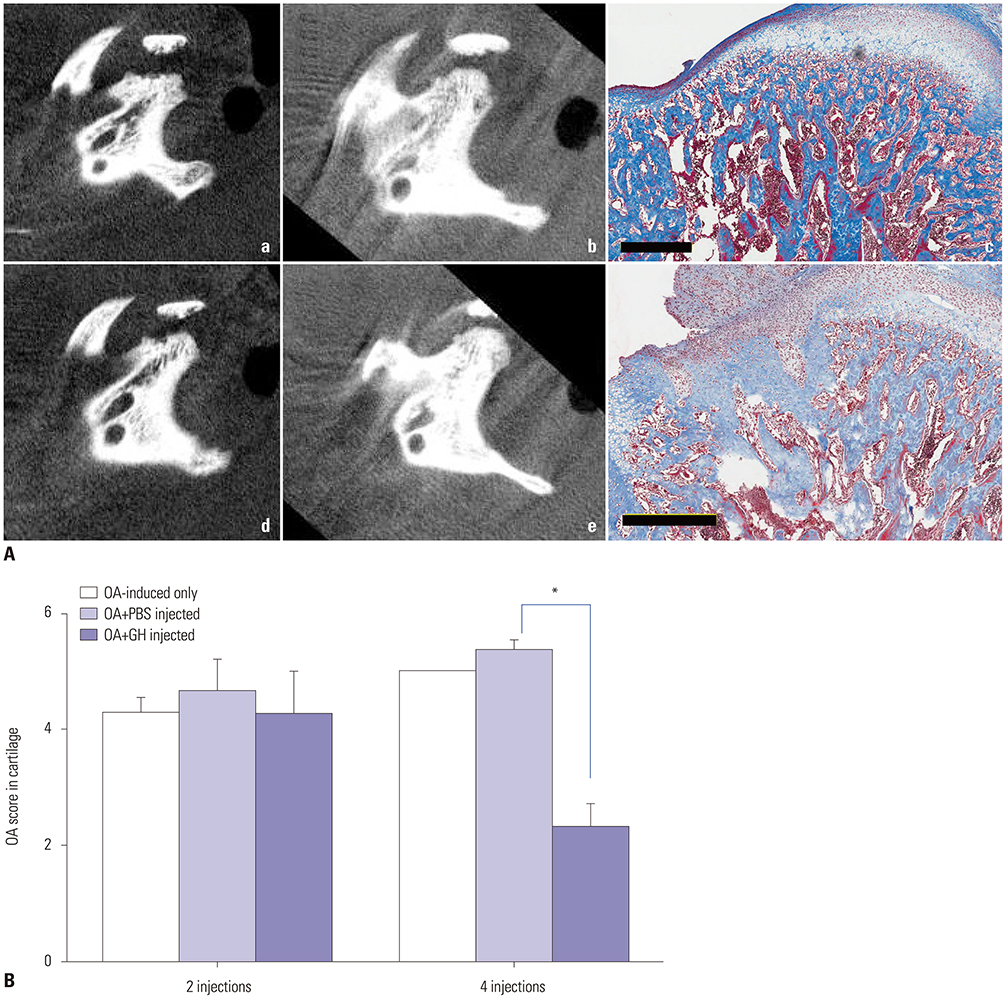Yonsei Med J.
2020 Apr;61(4):331-340. 10.3349/ymj.2020.61.4.331.
Local Injection of Growth Hormone for Temporomandibular Joint Osteoarthritis
- Affiliations
-
- 1Department of Oral Medicine, Dental Research Institute, Pusan National University Dental Hospital, Yangsan, Korea. drcookie@pusan.ac.kr
- 2Department of Oral Medicine, Dental and Life Science Institute, Pusan National University School of Dentistry, Yangsan, Korea.
- 3Department of Microbiology & Immunology, Pusan National University School of Medicine, Yangsan, Korea.
- 4Department of Oral Pathology, Pusan National University School of Dentistry, Yangsan, Korea.
- 5Deptartment of Oral Medicine, Busan Paik Hospital, Inje University, Busan, Korea.
- KMID: 2471919
- DOI: http://doi.org/10.3349/ymj.2020.61.4.331
Abstract
- PURPOSE
Osteoarthritis (OA) of the temporomandibular joint (TMJ) elicits cartilage and subchondral bone defects. Growth hormone (GH) promotes chondrocyte growth. The aim of this study was to evaluate the efficacy of intra-articular injections of GH to treat TMJ-OA.
MATERIALS AND METHODS
Monosodium iodoacetate (MIA) was used to induce OA in the TMJs of rats. After confirming the induction of OA, recombinant human GH was injected into the articular cavities of rats. Concentrations of GH and IGF-1 were measured in the blood and synovial fluid, and OA grades of cartilage and subchondral bone degradation were recorded by histological examination and micro-computed tomography.
RESULTS
MIA-induced OA in the rat TMJ upregulated insulin-like growth factor-1 (IGF-1) rather than GH levels. GH and IGF-1 concentrations were increased after local injection of GH, compared with controls. Locally injected GH lowered osteoarthritic scores in the cartilage and subchondral bone of the TMJ.
CONCLUSION
Intra-articular injection of GH improved OA scores in rat TMJs in both cartilage and subchondral bone of the condyles without affecting condylar bone growth. These results suggest that intra-articular injection of human GH could be a suitable treatment option for TMJ-OA patients in the future.
MeSH Terms
Figure
Reference
-
1. Su N, Liu Y, Yang X, Shen J, Wang H. Correlation between oral health-related quality of life and clinical dysfunction index in patients with temporomandibular joint osteoarthritis. J Oral Sci. 2016; 58:483–490.
Article2. Billiau AD, Hu Y, Verdonck A, Carels C, Wouters C. Temporomandibular joint arthritis in juvenile idiopathic arthritis: prevalence, clinical and radiological signs, and relation to dentofacial morphology. J Rheumatol. 2007; 34:1925–1933.3. Bilgiç F, Gelgör İE. Prevalence of temporomandibular dysfunction and its association with malocclusion in children: an epidemiologic study. J Clin Pediatr Dent. 2017; 41:161–165.
Article4. Ok SM, Kim CY, Jeong SH, Ahn YW, Ko MY. Comparative analysis: the patterns of temporomandibular disorder among adolescents. J Oral Med Pain. 2012; 37:47–59.
Article5. Kajii TS, Fujita T, Sakaguchi Y, Shimada K. Osseous changes of the mandibular condyle affect backward-rotation of the mandibular ramus in Angle Class II orthodontic patients with idiopathic condylar resorption of the temporomandibular joint. Cranio. 2019; 37:264–271.
Article6. Wolford LM, Reiche-Fischel O, Mehra P. Changes in temporomandibular joint dysfunction after orthognathic surgery. J Oral Maxillofac Surg. 2003; 61:655–660.
Article7. Nilsson O, Marino R, De Luca F, Phillip M, Baron J. Endocrine regulation of the growth plate. Horm Res. 2005; 64:157–165.
Article8. Nemirovskiy O, Zheng YJ, Tung D, Korniski B, Settle S, Skepner A, et al. Pharmacokinetic/pharmacodynamic (PK/PD) differentiation of native and PEGylated recombinant human growth hormone (rhGH and PEG-rhGH) in the rat model of osteoarthritis. Xenobiotica. 2010; 40:586–592.
Article9. Bail H, Klein P, Kolbeck S, Krummrey G, Weiler A, Schmidmaier G, et al. Systemic application of growth hormone enhances the early healing phase of osteochondral defects--a preliminary study in micropigs. Bone. 2003; 32:457–467.
Article10. Reinecke M, Schmid AC, Heyberger-Meyer B, Hunziker EB, Zapf J. Effect of growth hormone and insulin-like growth factor I (IGF-I) on the expression of IGF-I messenger ribonucleic acid and peptide in rat tibial growth plate and articular chondrocytes in vivo. Endocrinology. 2000; 141:2847–2853.
Article11. Dunn AR. Morphoangiogenesis: a unique action of growth hormone. Microvasc Res. 2002; 63:295–303.
Article12. Kim SB, Kwon DR, Kwak H, Shin YB, Han HJ, Lee JH, et al. Additive effects of intra-articular injection of growth hormone and hyaluronic acid in rabbit model of collagenase-induced osteoarthritis. J Korean Med Sci. 2010; 25:776–780.
Article13. Laron Z. Insulin-like growth factor 1 (IGF-1): a growth hormone. Mol Pathol. 2001; 54:311–316.
Article14. Wei FY, Lee JK, Wei L, Qu F, Zhang JZ. Correlation of insulin-like growth factor 1 and osteoarthritic cartilage degradation: a spontaneous osteoarthritis in guinea-pig. Eur Rev Med Pharmacol Sci. 2017; 21:4493–4500.15. Daughaday WH. Growth hormone axis overview--somatomedin hypothesis. Pediatr Nephrol. 2000; 14:537–540.16. Demarquay D, Dumontier MF, Bourguignon J, Hintz RL, Corvol MT. Stimulation by GH of IGF1 proforms synthesized by rabbit chondrocytes cultured with bFGF in serum-free medium. Exp Cell Res. 1992; 202:412–422.
Article17. Páramo C, Fluiters E, de la Fuente J, Andrade A, García-Mayor RV. Monitoring of treatment success in patients with acromegaly: the value of serum insulin-like growth factor binding protein-3 and serum leptin measurements in comparison to plasma insulin-like growth factor I determination. Metabolism. 2001; 50:1117–1121.
Article18. Wang XD, Kou XX, He DQ, Zeng MM, Meng Z, Bi RY, et al. Progression of cartilage degradation, bone resorption and pain in rat temporomandibular joint osteoarthritis induced by injection of iodoacetate. PLoS One. 2012; 7:e45036.
Article19. Khan I, El-Kadi AO, El-Bialy T. Effects of growth hormone and ultrasound on mandibular growth in rats: MicroCT and toxicity analyses. Arch Oral Biol. 2013; 58:1217–1224.
Article20. Møystad A, Mork-Knutsen BB, Bjørnland T. Injection of sodium hyaluronate compared to a corticosteroid in the treatment of patients with temporomandibular joint osteoarthritis: a CT evaluation. Oral Surg Oral Med Oral Pathol Oral Radiol Endod. 2008; 105:e53–e60.
Article21. Kwon DR, Park GY, Lee SU. The effects of intra-articular plateletrich plasma injection according to the severity of collagenase-induced knee osteoarthritis in a rabbit model. Ann Rehabil Med. 2012; 36:458–465.
Article22. Su N, Liu Y, Yang X, Shen J, Wang H. Association of malocclusion, self-reported bruxism and chewing-side preference with oral health-related quality of life in patients with temporomandibular joint osteoarthritis. Int Dent J. 2018; 68:97–104.
Article23. Wahlund K, Larsson B. Long-term treatment outcome for adolescents with temporomandibular pain. Acta Odontol Scand. 2018; 76:153–160.
Article24. Iturriaga V, Bornhardt T, Manterola C, Brebi P. Effect of hyaluronic acid on the regulation of inflammatory mediators in osteoarthritis of the temporomandibular joint: a systematic review. Int J Oral Maxillofac Surg. 2017; 46:590–595.
Article25. Machado E, Bonotto D, Cunali PA. Intra-articular injections with corticosteroids and sodium hyaluronate for treating temporomandibular joint disorders: a systematic review. Dental Press J Orthod. 2013; 18:128–133.
Article26. Liu XW, Hu J, Man C, Zhang B, Ma YQ, Zhu SS. Insulin-like growth factor-1 suspended in hyaluronan improves cartilage and subchondral cancellous bone repair in osteoarthritis of temporomandibular joint. Int J Oral Maxillofac Surg. 2011; 40:184–190.
Article27. Ohlsson C, Bengtsson BA, Isaksson OG, Andreassen TT, Slootweg MC. Growth hormone and bone. Endocr Rev. 1998; 19:55–79.
Article28. Lewinson D, Harel Z, Shenzer P, Silbermann M, Hochberg Z. Effect of thyroid hormone and growth hormone on recovery from hypothyroidism of epiphyseal growth plate cartilage and its adjacent bone. Endocrinology. 1989; 124:937–945.
Article29. Wang J, Zhou J, Cheng CM, Kopchick JJ, Bondy CA. Evidence supporting dual, IGF-I-independent and IGF-I-dependent, roles for GH in promoting longitudinal bone growth. J Endocrinol. 2004; 180:247–255.
Article30. Güler N, Kürkçü M, Duygu G, Cam B. Sodium iodoacetate induced osteoarthrosis model in rabbit temporomandibular joint: CT and histological study (part I). Int J Oral Maxillofac Surg. 2011; 40:1289–1295.
Article31. Loeser RF, Pacione CA, Chubinskaya S. The combination of insulin-like growth factor 1 and osteogenic protein 1 promotes increased survival of and matrix synthesis by normal and osteoarthritic human articular chondrocytes. Arthritis Rheum. 2003; 48:2188–2196.
Article32. Visnapuu V, Peltomäki T, Rönning O, Vahlberg T, Helenius H. Growth hormone and insulin-like growth factor I receptors in the temporomandibular joint of the rat. J Dent Res. 2001; 80:1903–1907.
Article33. Waters MJ, Hoang HN, Fairlie DP, Pelekanos RA, Brown RJ. New insights into growth hormone action. J Mol Endocrinol. 2006; 36:1–7.
Article34. Farquharson C, Ahmed SF. Inflammation and linear bone growth: the inhibitory role of SOCS2 on GH/IGF-1 signaling. Pediatr Nephrol. 2013; 28:547–556.
Article35. Denko CW, Boja B, Moskowitz RW. Growth factors, insulin-like growth factor-1 and growth hormone, in synovial fluid and serum of patients with rheumatic disorders. Osteoarthritis Cartilage. 1996; 4:245–249.
Article36. Denko CW, Malemud CJ. Role of the growth hormone/insulin-like growth factor-1 paracrine axis in rheumatic diseases. Semin Arthritis Rheum. 2005; 35:24–34.
Article37. Mathews LS, Hammer RE, Behringer RR, D'Ercole AJ, Bell GI, Brinster RL, et al. Growth enhancement of transgenic mice expressing human insulin-like growth factor I. Endocrinology. 1988; 123:2827–2833.
Article38. Lupu F, Terwilliger JD, Lee K, Segre GV, Efstratiadis A. Roles of growth hormone and insulin-like growth factor 1 in mouse postnatal growth. Dev Biol. 2001; 229:141–162.
Article39. Ahmed SF, Farquharson C. The effect of GH and IGF1 on linear growth and skeletal development and their modulation by SOCS proteins. J Endocrinol. 2010; 206:249–259.
Article
- Full Text Links
- Actions
-
Cited
- CITED
-
- Close
- Share
- Similar articles
-
- Necessity of standardized protocol for platelet-rich plasma therapy in temporomandibular joint osteoarthritis
- Intra-Articular Hyaluronic Acid Injection in Ankle Osteoarthritis
- A Large Subchondral Cyst in an Osteoarthritic Temporomandibular Joint: A Case Report
- The Association between Temporomandibular Joint Disorders and Lumbar Diseases in Adults
- Aspiration and Injection of the Knee Joint: Approach Portal







